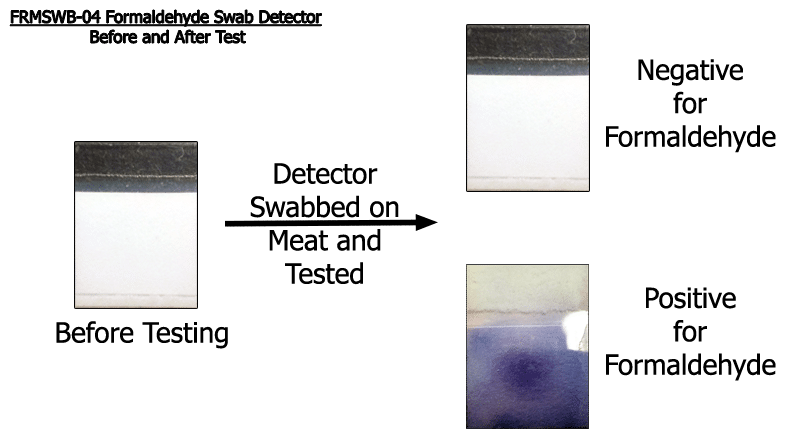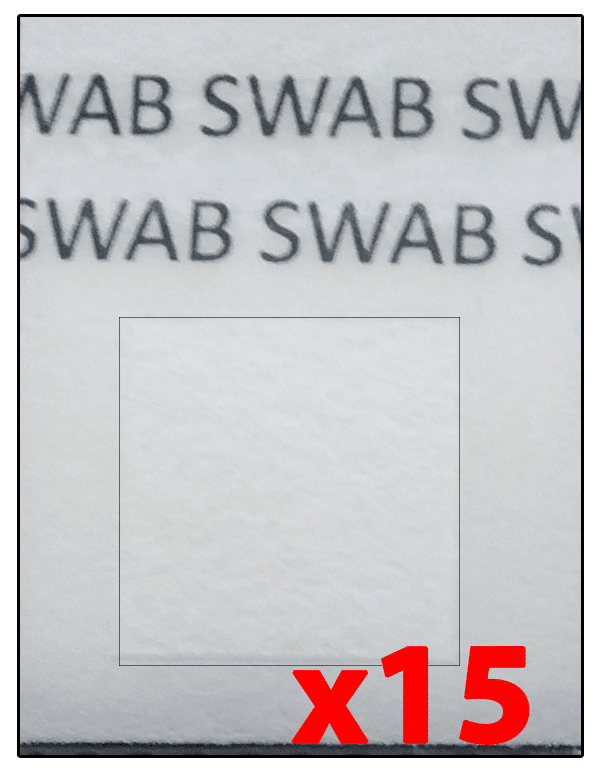Overview
ChemSee’s Formaldehyde Swab Detectors allow for rapid, easy detection of Formaldehyde in / on the surface of food (PATENT PENDING). This instant detector is rubbed on the surface of a wet suspect sample and will change its color. The color change is a bright purple color which is easily visible by even colorblind people.
Demonstration Video
How it works

A simple color change alerts the user when Formaldehyde is present.
The detectors can be used to test foods such as Fish, Shrimp, Meat, Cheese or even Liquids for the presence of Formaldehyde. Full instructions are provided to ensure that all tests are performed properly.
Testing for Formaldehyde can be completed in LESS THAN THREE MINUTES.
Features and Benefits
| Features | Benefits |
| • Detects Formaldehyde using a Single Test Strip/Detector. | • User does not need to Mix Solutions. |
| • Obtains Results in Less than Three Minutes. | • User can Analyze Foods On-Site. |
| • The Detectors are Non-Toxic. | • Tested Foods can still be Eaten, if Negative. |
| • No Additional Tools / Accessories Required. | • Tests are Convenient and Low-Cost. |
| • The Detectors are able to Test any Food. | • Detectors are very Versatile. |
| • Small Size and Weight. | • No Special Storage Requirements. |
| • New Technology. (Patent Pending) |
Results Found
ChemSee has tested many commercially available foods for the presence of Formaldehyde. Tests have been ran in duplicates, as well as on different batches of the same fish. A portion of the results from API’s tests can be found below.
| # | Type of Sample | Local or Imported | Results |
| 1 | Swai (Fish) | Imported | Positive |
| 2 | Tilapia (Fish) | Local | Negative |
| 3 | Tuna (Fish) | Local | Negative |
| 4 | Cod (Fish) | Imported | Positive |
| 5 | Tilapia (Fish) | Local | Negative |
| 6 | Swai (Fish) | Local | Negative |
| 7 | Cod (Fish) | Imported | Positive |
| 8 | Cod 2 (Fish) | Imported | Positive |
| 9 | Pollock (Fish) | Imported | Positive |
| 10 | Shrimp (Fish) | Imported | Positive |
| 11 | Swai (Fish) | Imported | Positive |
| 12 | Tilapia 1 (Fish) | Imported | Positive |
| 13 | Whiting (Fish) | Imported | Positive |
| 14 | Cod 3 (Fish) | Imported | Positive |
| 15 | Salmon (Fish) | Local | Weak Positive <5 ppm |
| 16 | Tilapia (Fish) | Local | Weak Positive <5 ppm |
| 17 | Lamb | Local | Negative |
| 18 | Mexican Taco Cheese | Local | Negative |
| 19 | Colby Jack Cheese | Local | Negative |
| 20 | Sharp Cheddar | Local | Negative |
| 21 | Whole Milk Ricotta Cheese | Local | Weak Positive <5 ppm |
| 22 | Cottage Cheese | Local | Weak Positive <5 ppm |
| 23 | Low-Fat Cottage Cheese | Local | Weak Positive <5 ppm |
| 24 | Greek Nonfat Yogurt | Local | Weak Positive <5 ppm |
| 25 | Sour Cream | Local | Weak Positive <5 ppm |
It was found that many of the fish imported from other countries such as China, Indonesia and Vietnam have much higher levels of Formaldehyde than what is naturally present in fish. This may indicate intentional adulteration to increase the food’s shelf-life.
